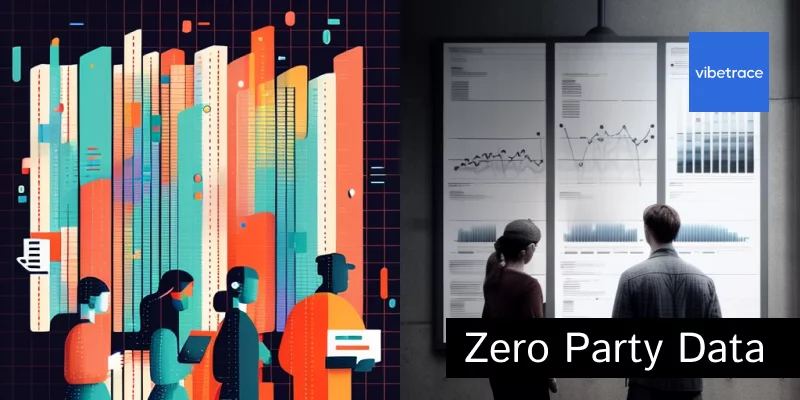Customer data is gold. While it’s a valuable commodity in e-commerce, the manner in which it’s collected has been a serious concern among customers.
With privacy breaches and data leaks becoming common, mistrust from the public has only grown and become more widespread.
So, when Google announced its plans to phase out third-party cookies in 2020, e-commerce companies were compelled to find new ways to gather user data.
In a world that’s soon to be cookieless, companies must find new and innovative ways to gather information about their target markets.
While first-party data that’s gathered through cookies has been the norm, methods that enable zero-party data need to be prioritized and explored by forward-thinking companies.
Though first-party data has been around for some time, zero-party data is emerging as the newer, cooler kid on the block. And a profitable one at that.
Before we understand how each works, it’s essential to understand what they are and what they entail.
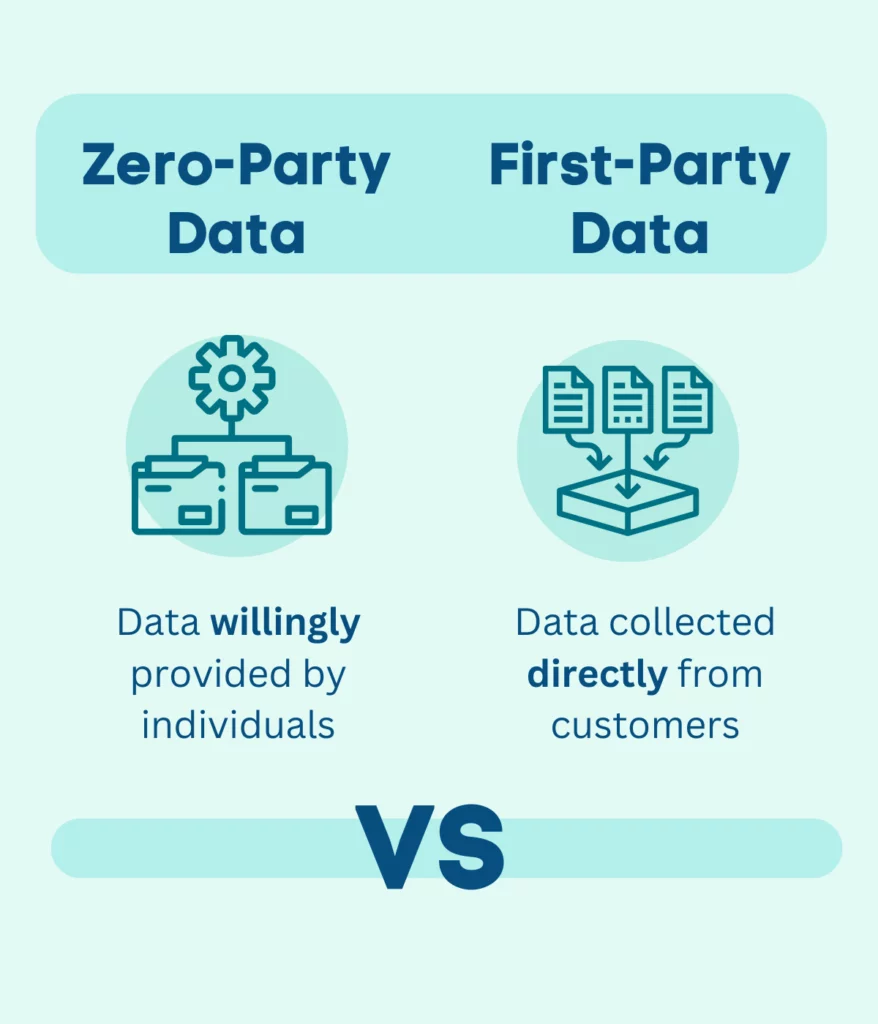
What Is Zero-Party Data?
Any data collected directly from the customer, voluntarily or proactively, is zero-party data. The term was first coined in 2018 by Forrester Research.
It’s information that a customer voluntarily provides to a business—Information like a customer’s:
- Preferences
- Purchase intentions
- Background
- How the person wants the brand to recognize them
Consider it the same as conversational data. You can learn about their birthday, favorite color, and other information.
Data collecting, marketing, and interactions become more conversational when you take this approach with your clients.
This change provides detailed information that helps your company flourish and customers feel valued when they shop for what they need.
You can collect zero-party data using Vibetrace Behaviour Analytics solution that collects automatically customer behaviour on your retail/website.
It is popularly considered an extension of explicit data because the customer explicitly shares it with the organization to help them deliver personalized experiences.
This type of data is generally collected with the promise of a reward such as a free e-book, webinar, discounts, and more.
Benefits of Zero Party Data
It will help if you communicate with your clientele, as they are eager to hear from you. It’s one of the key reasons they give you this information.
Among the most apparent benefits of zero party data are:
- Value and clarity: Zero party data is unique because it comes straight from the customer, so your business can be confident that a customer wants to hear from you
- Cost-effective: Costs to collect zero party data are low because the information is already within your systems. Zero party data is free, unlike second and third-party data, because customers volunteer it
- Relevance: The direct nature of zero party data allows you to gain insight into how your clients want you to contact them. It helps you to tailor your interactions to their preferences
- Compliant: The risks associated with zero party data collection are low because you know the data’s origin and collection method.
One potential drawback of zero party data collection is that it’s counterproductive to ask clients for too much data all at once. It’s best to spread out your request intervals for this info.
But the advantage of having the data ready for customer segmentation is way above any drawbacks. It increases your marketing Return on Investment and tells you what to do next.

How to Collect Zero Party Data
What’s great about zero party data is that you can use whatever methods you like to gather it. Ingenious marketers have created a variety of innovative strategies to get this data while still making the process enjoyable for customers.
Collecting Zero Party Data from Visitors
Businesses can gather zero-party data from their site visitors in several ways—Though it will vary from person to person. Below are useful tips for collecting zero party data from visitors.
Conversational Pop-Up
Pop-ups with questions about the visitor’s interests and requirements can help you tailor your site’s content to them and turn them into lifelong customers. Consider conversational pop-ups as the online version of a retail check-in.
Each prospect can provide you with one or two data points by answering a few questions in these pop-ups. They help with customization and conversion rates without being annoying to visitors.
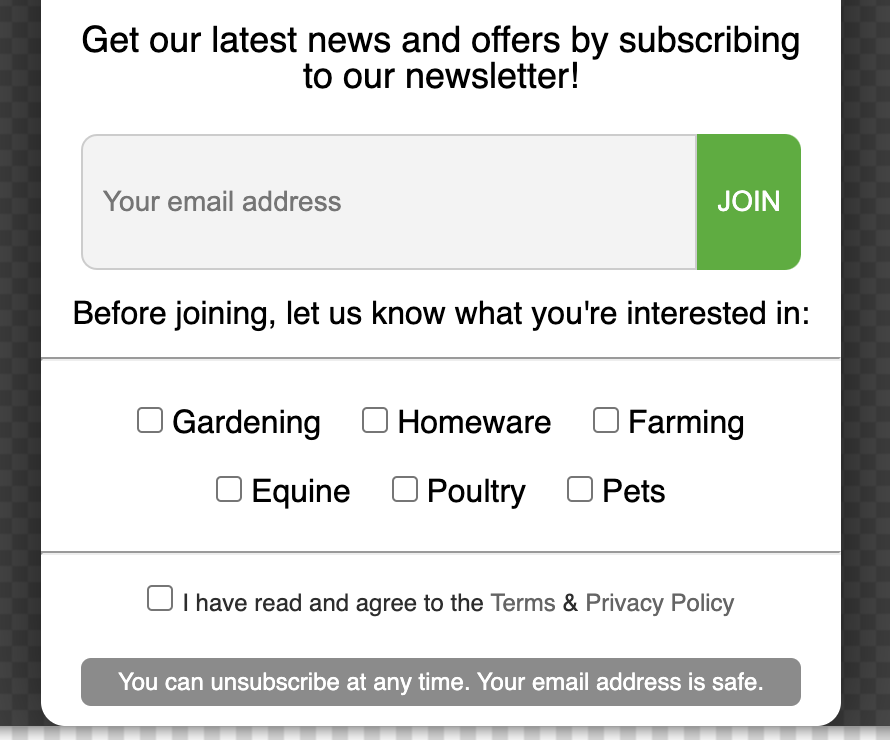
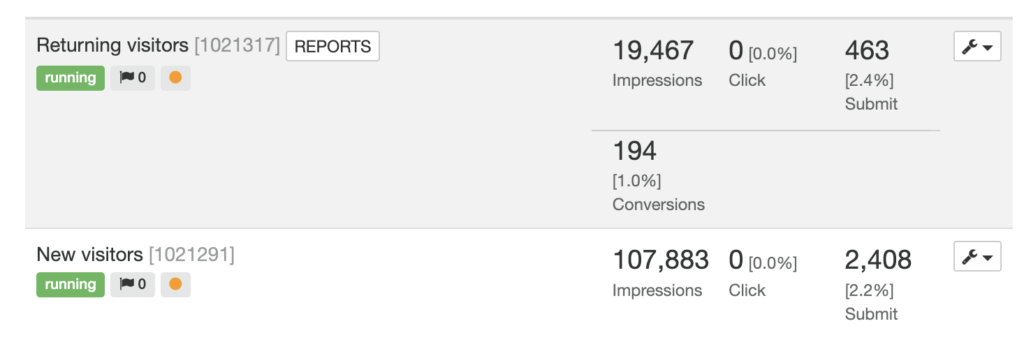
Social Networking
Social networking is the way to go if you want to reach a wide audience, including prospects. Creating and publishing polls on social networks can help you get a wide range of information on trends, community dynamics, and product directions.
For example, a common marketing question posed by companies when comparing products is, “which do you prefer?” Think of it as A/B testing, but instead of comparing two options, you get customer feedback.
Using polls on social media platforms like Twitter and Instagram has shown to increase client engagement with a company by 20-40%. This kind of input is crucial in the early stages of a campaign.
Collecting Zero Party Data from Customers
The Pareto principle states that a small percentage of your clientele will generate most of your revenue. As a result, your company’s success will depend on your ability to maintain the satisfaction and loyalty of your most valuable clientele.
Success in collecting zero party data will vary depending on individual preferences, but the following are some pointers.
Member Attributes
The most fundamental is collecting members’ personal information either at signup or later. Using this feature, you can learn more about a consumer than just their name, email address, and phone number.
For example with Vibetrace you can collect: birthdays, interests, first&last name using Interaction, Content or Survey campaigns.
All the information from the forms is sent automatically to your own customer database that Vibetrace builds for you.
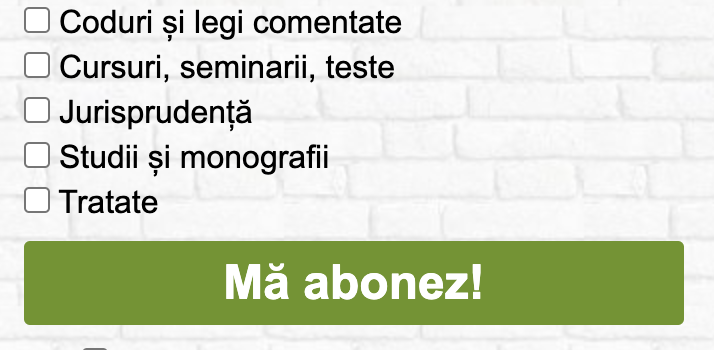
Pop-Up Quizzes
One more effective strategy is to present a short pop-up survey to a new user. It can be a few questions, the answers to which will help them find the most relevant products.
Opinion Polls
Online polls allowing users to vote on various options are also widespread today. For example, asking prospects about their preferred styles and more.
It contributes to the staff’s sense of community and ownership of the company’s future.
Each approach has merits, but combining them is where you’ll find the most progress toward your goals.

How to Store and Manage Zero Party Data
What do you do with zero party data once you have it in your database, now that you know what it is and how to gather it?
To succeed, you need a zero-party data strategy around the consumer. With customers’ consent, collecting their data can be a smooth process.
This is what we call customer database or customer data platform.
Businesses can use it in marketing campaigns and activities like any other data. In contrast to other data kinds, you create hyper-personalized messages and content by:
- Using A/B testing to narrow in on user tastes
- Customizing user experiences on websites
- Enhancing the satisfaction of your customers
- Sending emails based on a user’s persona
- Analyzing how customers’ actions contribute to churn
- Ad retargeting
Vibetrace stores and manages his data for you automatically.
Case Study of a Zero Data Strategy: The Language-Study App Babbel
Babbel invites people who sign up to answer a few personal questions like:
- “Why do you want to learn a new language?”
- “What level do you aim to reach?”
- “How much time can you devote to studying every day?”
- “How old are you?”
How to Utilize Zero Party Data
You can leverage clients’ zero party data once you’ve collected it in several ways.
Optimize the Customer Experience by Making It Unique
You can use zero party data to give your customers a better, more tailored experience. For example, zero party data lets you cater your marketing and deals to each consumer based on their specific preferences. It can help you deliver a more personalized experience for your customers, which increases their loyalty and interest in your brand.
Optimization of Customer Segmentation
Targeting your ideal clientele more effectively is another area where zero party data can help. The success of your marketing and sales efforts will increase as you learn more about your client’s likes and dislikes.
Plus, you can guarantee that your messages and offers get delivered to the appropriate customers. Boosting your marketing and sales efforts in this way can lead to more success and growth.
Refine Your Approach to Serving Your Clients
Improving communication with customers is yet another use for zero party data. Gaining insight into a customer’s preferences allows you to tailor your service to them.
For example, you can use zero party data to match customers’ preferences with relevant products and services.
Alternatively, you can use their prior actions to make specific suggestions for them. As a result, you will enhance your customers’ service and increase their likelihood of sticking with you.
What Is First-Party Data?
First-party data is unique information about the customer’s behavior.
It’s collected through the organization’s platforms, including its website, social media, and more. This information usually includes their locations, languages, preferences, the type of websites they visit, the items they are interested in, and more.
Code is placed on the organization’s website and analytic platforms are used to collect this data.
While they may sound like they’re doing the same thing, one key difference exists. It pertains to how data is collected.
With zero-party data, the customer and organization are in direct conversation with each other. First-party data, on the other hand, is collected via analytics and user activity.
What is Cookieless Marketing?
Cookieless marketing is the concept of targeting and tracking users for the purpose of delivering an effective marketing message without the use of cookies.
Cookieless marketing is becoming increasingly popular as the use of cookies declines.
It involves using a variety of approaches to target and tracks potential customers, including using technology such as machine learning and Artificial Intelligence (AI), tracking customer actions and behaviors, leveraging data obtained from third-party sources, and collecting data from connected devices.
Cookieless marketing can help e-commerce businesses create more effective marketing campaigns and gain deeper customer insights.
Importance of Zero- and First-Party Data to E-commerce Marketers
Since data is collected directly from customers, the quality and authenticity of the data are high. This is particularly useful for marketers who want to create highly personalized customer experiences based on market preferences, interests, demographics, and more.
This, in turn, helps boost user engagement, customer retention, and brand/platform affinity.
More notably, marketers can boost their outreach strategies with:
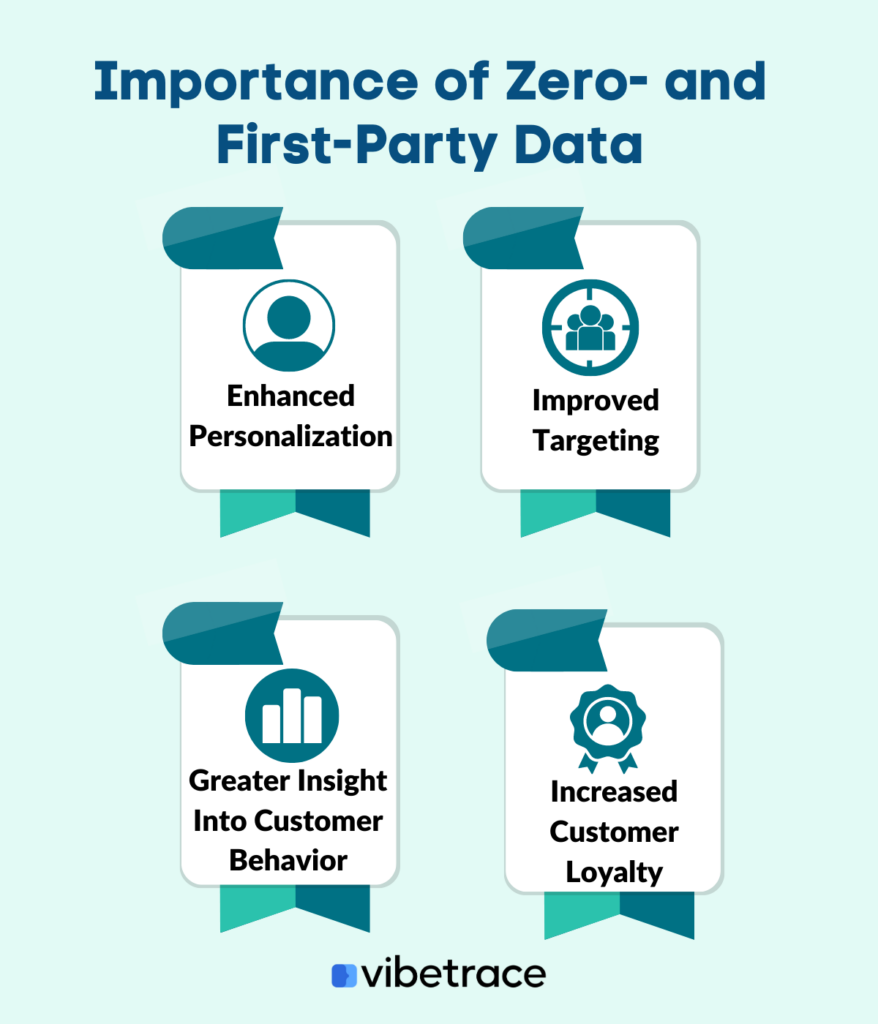
Enhanced Personalization
Since customer information is collected directly from them, there is little room for error.
E-commerce marketers can analyze available data and create personalized buying experiences for customers they actually want and value.
Moreover, customer touchpoints that actively solicit information from customers help them feel involved and heard.
Improved Targeting
Data from third-party companies is useful. But it’s also shared with thousands of other companies. Data from zero- and first-parties is exclusive and relevant to only that particular organization.
This means marketers don’t have to spend hours analyzing and contextualizing information from third-party data. Since they get to call the shots on the information that they collect, they can more accurately target their customers and reap profitable returns.
Greater Insight Into Customer Behavior
With advanced, first-hand access to customer data, gaining deeper insight into customer psychographics is remarkably easy.
Organizations can better understand their customers’ personalities, lifestyles, likes, dislikes, habits, behavioral patterns, and interests, which are effective in developing highly effective outreach strategies.
Increased Customer Loyalty
The goal of any marketing team is to cultivate customer loyalty. Earlier, organizations were forced to come up with semi-informed guesses in hopes that they would work.
Zero- and first-party data enables teams to analyze organization-unique data, create strategic, targeted campaigns and products that customers value immensely, and increase customer loyalty more effectively.
Learn how to increase customer loyalty for Shopify stores
Marketing Strategies Based on Zero- And First-Party Data
There is no IF question about implementing Zero and First Party Data marketing. The question is only WHEN will you be forced to have it implemented in order not to lose valuable data regarding your customers and visitors.
Here’s how you can create marketing strategies using zero- and first-party data:
How is data collected?
Zero-party data is collected directly from customers by the organization that will use it via strategically curated quizzes, conversational pop-ups, surveys, social media polls, contests, onboarding, and more.
Conversely, first-party data is based on users’ online activities and behaviors.
They are collected through website forms, newsletters and ebooks, social media and webpage analytics, and customer surveys. There is no direct interaction between the company that will use the data and the users they gather it from.
Zero-party data does not require analysis. First-party data is collected from online user behaviors and other analytical software and needs analysis to derive actionable insights.
Use Data to Design Segmentation Strategies
Once data is collected and analyzed, it is now time to create strategic audience segments. Based on these, marketers can develop buyer personas and build unique positioning strategies and strong outreach campaigns to engage each segment.
This enables enhanced customer experiences that drive sales and high return on investment (ROI).
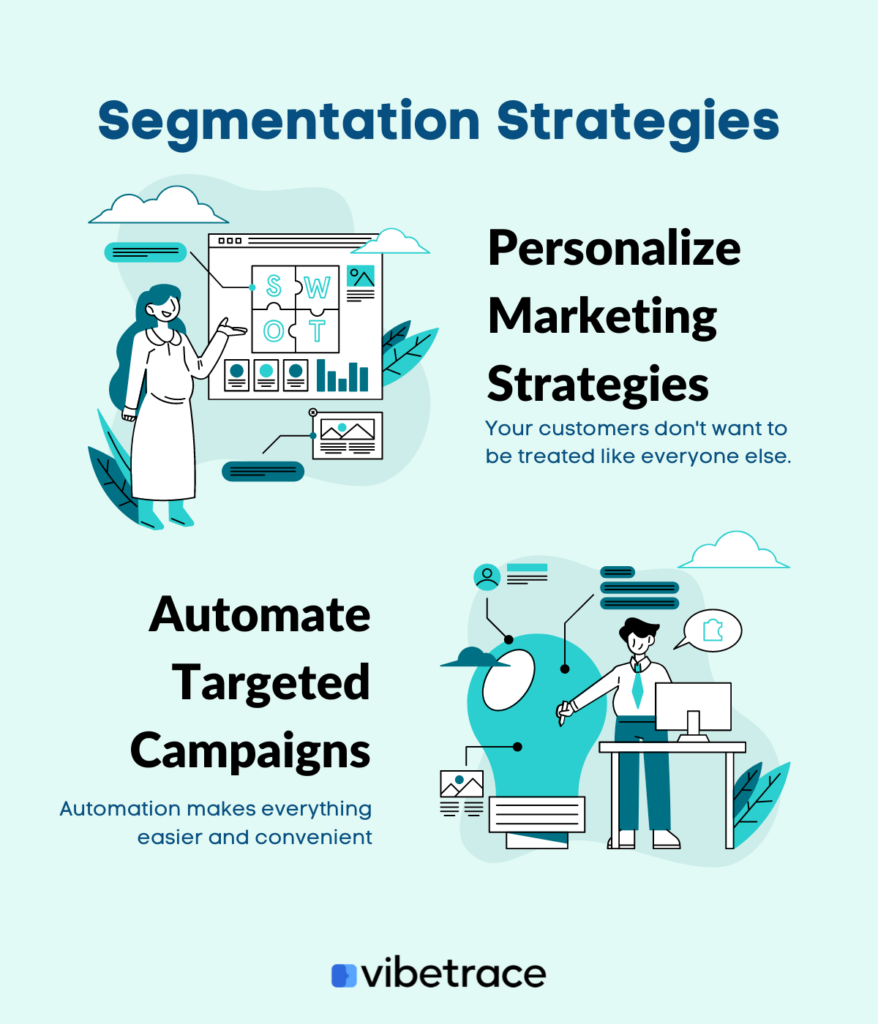
Want to be up to date with Marketing?
Subscribe to our Retail CX newsletter!

Stay connected with what’s really important to optimize your digital revenues.
By clicking the button, you accept our Terms & Conditions. Also you will need to confirm your email address.
Personalize Your Marketing Strategies
E-commerce marketers often face a confusing paradox. On the one hand, customers expect personalized brand messages while being concerned about their privacy and how their data is collected. But they also expect uniquely crafted experiences at different stages of their buying journey.
Customers don’t mind organizations using data to create personalized experiences for them. According to a McKinsey report, 71% of customers expect companies to deliver personalized interactions.
But there’s a caveat. These experiences must always be based on data they have explicitly shared with the organization, not external sources.
Hence, personalization is vital. No customer wants to be treated like everyone else and companies are rapidly turning to data to tailor their outreach plans.
The McKinsey report also noted that companies that provided personalized experiences saw a 40% faster increase in ROI compared to those that did not deliver customized interactions.
Personalization is comprised of those “micro-moments” that brands create at different stages of the marketing funnel which are unique to that customer.
For instance, sending a discount coupon via email to prompt a potential buyer to check out items from an abandoned online cart. It could also mean sending a branded DIY video about a product they’ve been looking at for the past few days.
However, organizations must also be cautious when dealing with sensitive customer data. It should be collected efficiently, stored securely, used responsibly, and gathered with utmost transparency.
Automate Targeted Campaigns
Once data is collected, analyzed, and segmented, your marketing campaigns are ready to be distributed. But how? You cannot expect your marketing and sales team to send targeted campaigns manually. It’s time- and labor-intensive.
Plus, for real profit, you must think about scaling things up.
Automation has been a hot topic in marketing circles for a long time now and for good reason. Eighty percent of e-commerce marketers reported increased lead generation while 77% noted higher conversions.
Engaging your customers at different touchpoints in their buying journey has become easy, seamless, and error-free. There are emails, push notifications, live chats, and other channels that have or can be integrated with automation features.
Today’s automated marketing software is packed with dedicated templates that are highly customizable and can be seamlessly and accurately sent to specific market segments.
You can automatically send targeted campaigns to your market segments based on contextual needs.
Examples of these include warm welcome emails, reminder emails with incentives to encourage purchases and boost retention, follow-up emails for lead generation, feedback requests to understand the shopping quality experience, and more.
Automated software also provides real-time analytical insights. In an industry where agility is critical, marketers can leverage such information during important promotions and campaigns to boost optimization and scale performance.
Conclusion
Zero- and first-party data deliver one thing — organization-unique data that is considered more of a digital currency these days.
E-commerce marketers have acknowledged the importance of transparency and ethical data collection in a space where customers are increasingly concerned about how their data is collected and what it is used for.
Moreover, outreach plans need to be based on highly accurate data and savvy marketers are taking note of this. Fortunately, zero- and first-party data is proving far more helpful in creating innovative and engaging customer experiences based on this requirement.
Such data also lends several significant advantages to new-age marketers, such as enhancing trust and transparency, shifting control to customers, and letting them decide on the type of information they want to share.
Data is now far more accurate and authentic while enabling well-informed, effective marketing campaigns.
It is abundantly clear that a data-driven marketing approach is the way of the future. In a competitive space, it’s more than just numbers.
Generic marketing activities are a thing of the past. And marketers are compelled to go the extra mile to truly understand their customers — what they like and dislike and how customers across cultures vary in behavior and preferences.
Companies who want to make the most of zero party data must think outside the box when using the information their consumers give them.
Businesses must remember that customers are always multifaceted individuals with fascinating life journeys.
The first step in giving customers what they want from your business is figuring out how to start a conversation with them. That way, you will nurture them through the sales cycle just like a good salesperson would in a store.
As a result, data-driven marketing campaigns perform better and drive desired customer actions.
Lastly, in the age of agility, real-time data on customer behavior can help e-commerce marketers optimize their strategies to suit the needs of individual customers at any given time.

